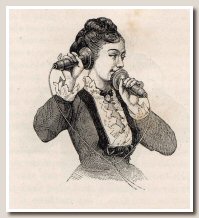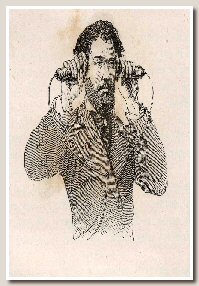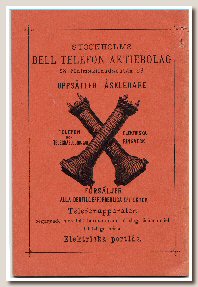|
|
|
|
History of the Telephone

It is not possible to retell the history of telephony exhaustively on a smaller website. Nor do I possess the requisite knowledge to do so. I will, however, briefly describe the development that makes up the background to the telephones and telephony accessories depicted herein.
|
Just like many other inventions, the origins of the telephone have been subject to controversy and already in the 19th century several of the valuable patents were litigated.
The question is also as to what level of development should be required to call the invention a "telephone".
The person managing to launch his invention successfully and during his contemporary period became the acknowledge inventor of a practically usable telephone was nevertheless the American, Alexander Graham Bell.
|

|
|
Bell submitted his patent application in February 1876 and had at this time only invented a rudimentary "ear piece" which by electrical means tolerably managed to transfer speech from one telephone to another.
|

|
The news about Bell's invention and its rather simple construction spread like wildfire all over the world and the invention was then quickly improved by many others such as Watson, Edison, Berliner, Siemens, and in Sweden, Lars Magnus Ericsson
Although Bell was granted certain patents on his invention, almost all manufacturers in every country copied his original construction, but then the development followed a number of parallel lines.
The news about the telephone arrived in Sweden in any event by 30 September 1876, on which date the newspaper Dagens Nyheter, in a small press item, reported of a “talking telegraph”. The paper referred to an English scientist who had made acquaintance with the fantastic invention when travelling in the USA, and referred to it as one of several "scientific peculiarities".
|
The first telephones sold commercially were those of Bell's and they were made by Charles Williams JR in Boston. It was in his workshop that Bell had been aided in constructing his first telephones. The telephone line between William's workshop and his house is also considered to be the first in the world.
A Norwegian engineer from Bergen in Norway put these telephones on display in Stockholm in August 1877. Among others, the Swedish King Oscar II, who reigned at the time, was then given the opportunity to test the invention.
|
Two months later, on 13 October 1877, the Stockholm firm Joseph Leja advertised in Dagens Nyheter that they had telephones for sale and that it was "completely new". But already in December the competing Numa Pettersson also had telephones in his product range. The company’s asking price was 12 kronor per telephone pair and 8 öre per foot of double-threaded telephone wire. In both of these cases it was probably a question of imported American telephones. At the same time, a Danish firm advertised corresponding German telephones.
Thus, in the beginning, telephones were mostly sold in pairs and were intended to be installed as internal telephone lines, often between two different premises, and by the hand of the pioneer himself.
|

|
It was only in the autumn of 1880 that the first actual network was built in Sweden. It was the so-called Bell Company in Stockholm that relied completely on imported American equipment connected to a likewise American shared telephone centre - a switchboard - operated by telephonists employed by the company, and some of the telephones of this type are also included in the exhibits.
|
|
Continue to History of Telegrafverket >>
|



